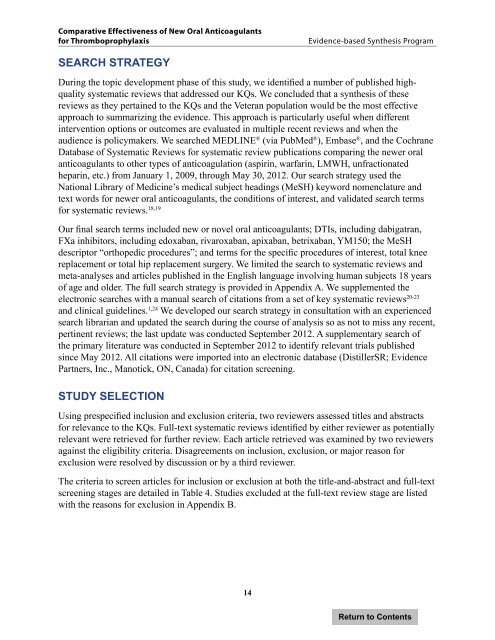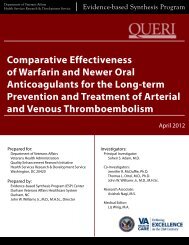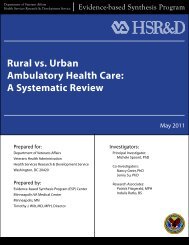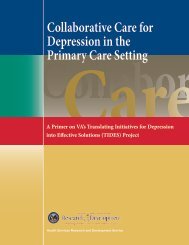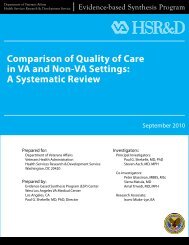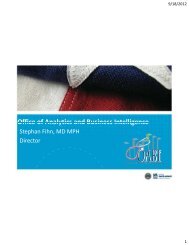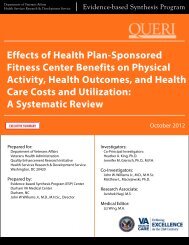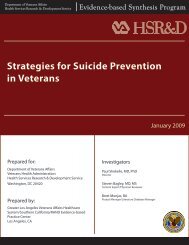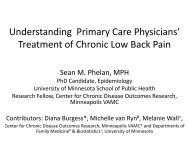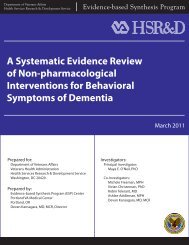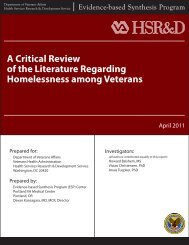Comparative Effectiveness of New Oral Anticoagulants for ...
Comparative Effectiveness of New Oral Anticoagulants for ...
Comparative Effectiveness of New Oral Anticoagulants for ...
You also want an ePaper? Increase the reach of your titles
YUMPU automatically turns print PDFs into web optimized ePapers that Google loves.
<strong>Comparative</strong> <strong>Effectiveness</strong> <strong>of</strong> <strong>New</strong> <strong>Oral</strong> <strong>Anticoagulants</strong><br />
<strong>for</strong> Thromboprophylaxis<br />
Evidence-based Synthesis Program<br />
SEARCH STRATEGY<br />
During the topic development phase <strong>of</strong> this study, we identified a number <strong>of</strong> published highquality<br />
systematic reviews that addressed our KQs. We concluded that a synthesis <strong>of</strong> these<br />
reviews as they pertained to the KQs and the Veteran population would be the most effective<br />
approach to summarizing the evidence. This approach is particularly useful when different<br />
intervention options or outcomes are evaluated in multiple recent reviews and when the<br />
audience is policymakers. We searched MEDLINE ® (via PubMed ® ), Embase ® , and the Cochrane<br />
Database <strong>of</strong> Systematic Reviews <strong>for</strong> systematic review publications comparing the newer oral<br />
anticoagulants to other types <strong>of</strong> anticoagulation (aspirin, warfarin, LMWH, unfractionated<br />
heparin, etc.) from January 1, 2009, through May 30, 2012. Our search strategy used the<br />
National Library <strong>of</strong> Medicine’s medical subject headings (MeSH) keyword nomenclature and<br />
text words <strong>for</strong> newer oral anticoagulants, the conditions <strong>of</strong> interest, and validated search terms<br />
<strong>for</strong> systematic reviews. 18,19<br />
Our final search terms included new or novel oral anticoagulants; DTIs, including dabigatran,<br />
FXa inhibitors, including edoxaban, rivaroxaban, apixaban, betrixaban, YM150; the MeSH<br />
descriptor “orthopedic procedures”; and terms <strong>for</strong> the specific procedures <strong>of</strong> interest, total knee<br />
replacement or total hip replacement surgery. We limited the search to systematic reviews and<br />
meta-analyses and articles published in the English language involving human subjects 18 years<br />
<strong>of</strong> age and older. The full search strategy is provided in Appendix A. We supplemented the<br />
electronic searches with a manual search <strong>of</strong> citations from a set <strong>of</strong> key systematic reviews 20-23<br />
and clinical guidelines. 1,24 We developed our search strategy in consultation with an experienced<br />
search librarian and updated the search during the course <strong>of</strong> analysis so as not to miss any recent,<br />
pertinent reviews; the last update was conducted September 2012. A supplementary search <strong>of</strong><br />
the primary literature was conducted in September 2012 to identify relevant trials published<br />
since May 2012. All citations were imported into an electronic database (DistillerSR; Evidence<br />
Partners, Inc., Manotick, ON, Canada) <strong>for</strong> citation screening.<br />
STUDY SELECTION<br />
Using prespecified inclusion and exclusion criteria, two reviewers assessed titles and abstracts<br />
<strong>for</strong> relevance to the KQs. Full-text systematic reviews identified by either reviewer as potentially<br />
relevant were retrieved <strong>for</strong> further review. Each article retrieved was examined by two reviewers<br />
against the eligibility criteria. Disagreements on inclusion, exclusion, or major reason <strong>for</strong><br />
exclusion were resolved by discussion or by a third reviewer.<br />
The criteria to screen articles <strong>for</strong> inclusion or exclusion at both the title-and-abstract and full-text<br />
screening stages are detailed in Table 4. Studies excluded at the full-text review stage are listed<br />
with the reasons <strong>for</strong> exclusion in Appendix B.<br />
14


